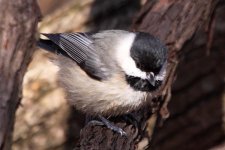howiewu
Well-known member
HI, greetings!
I understand the most reliable way to tell apart these birds is by their songs.
Problem is, I am not very good with bird songs/calls. Actually this is the case where I can tell the difference. But another problem is I usually go out a take some photos, then some time later I go through my pictures and I forget what I heard at the time
For example, I took the attached picture today in Northern Virgina. In this case I am pretty sure it is a Carolina Chickadee. But how am I supposed to tell if I only have the picture to look at?
TIA,
Howard
I understand the most reliable way to tell apart these birds is by their songs.
Problem is, I am not very good with bird songs/calls. Actually this is the case where I can tell the difference. But another problem is I usually go out a take some photos, then some time later I go through my pictures and I forget what I heard at the time
For example, I took the attached picture today in Northern Virgina. In this case I am pretty sure it is a Carolina Chickadee. But how am I supposed to tell if I only have the picture to look at?
TIA,
Howard












